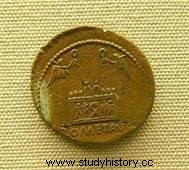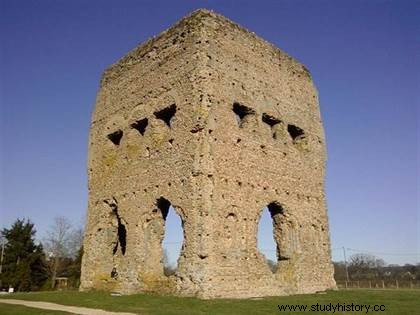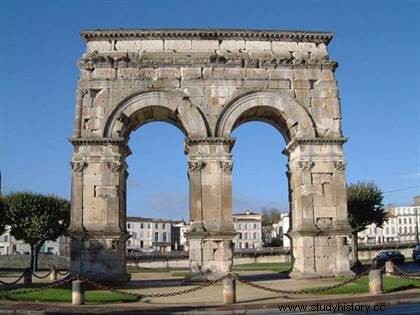 The conquest of Gaul by Caesar in 51 BC. J-C leads to their provincialization, and thus to their integration into the Empire, in particular with Auguste who created Lyonnaise, Aquitaine and Belgium, while Transalpine became Narbonnaise. However, what about the Gallic elites ? Did the notables also succeed in integrating into the imperial elites? What are their relations with Rome and the Emperor?
The conquest of Gaul by Caesar in 51 BC. J-C leads to their provincialization, and thus to their integration into the Empire, in particular with Auguste who created Lyonnaise, Aquitaine and Belgium, while Transalpine became Narbonnaise. However, what about the Gallic elites ? Did the notables also succeed in integrating into the imperial elites? What are their relations with Rome and the Emperor?
Sources
Evoking the Gallo-Roman elites poses a problem of sources, because they are few in number. With regard to the texts, in addition to the Comments of Caesar, we can cite Livy (died in 17 AD and close to Augustus), Strabo (died around 25 AD), but even more Tacitus and Suetonius, both living in the 2nd century AD. J-C.
Epigraphy is a major source, with inscriptions most often made by elites. Finally, funerary monuments also inform us about the Romanization of these elites.
We will deal here with the Gallo-Roman elites in the broad sense, that is to say the Gallic notables following the Romanization of Gaul. The latter are socially recognized at the local level, for political, administrative, or even broader activities such as the economic field. They become elites by integrating the highest spheres of power, up to the Senate in Rome. We will evoke here the Three Gauls and the Narbonnaise, up to the Antonins.
A “pro-Roman” Gallic elite?
Long before the Gallic Wars, there was already an elite that could be described as "pro-Roman". This is particularly the case among the Aedui. Their relationship with Rome dates back to around 120 BC. J-C, when the Romans defeat the Arverne Bituit, which benefits the Aedui. The latter then became privileged partners of Rome, especially for trade, so much so that they were considered “brothers inbred populi Romani” . It is therefore no coincidence that Caesar claims to respond to their call for help in 58, and that following the Gallic Wars it was, with his help, Aedui who became the first Gauls to enter the Senate. A predominance that we find later under Claude.
However, the Aedui are not the only ones already close to Rome. Indeed, from the Republican era, the Narbonnaise elites were culturally and institutionally Romanized, which ultimately gave them a more positive image in Rome than that of the notables of Hairy Gaul, Aedui included.
The domination of the Iulii
Victorious, Caesar rewards his allies with citizenship, a distribution considered generous and criticized, if we are to believe Suetonius (a source admittedly much later):" Caesar leads the Gauls to triumph, and also to the curia. The Gauls left their braies, they took the laticlave”. However, the reward is individual, as for grants of magistracies or gifts of land. The same is true under Augustus who founded Autun (Augustodunum ), new capital of the Aedui, where universities were created in which the Gallo-Roman notables learned Latin.

The role of Claudius in favor of the Gallo-Roman elites
Born in Lyon in 10 BC. J-C, emperor in 41 AD. J-C (he succeeds Caligula), Claude has close ties with Gaul. At its advent, Hairy Gaul no longer has full citizenship, and notables no longer have access to ius honour . Indeed, if under Caesar and at the beginning of Augustus, the Gauls (Iulii for the Three Gauls, Domitii , Valerii or Pompeii for the Narbonnaise) were able to access the equestrian order, even the Senate, this is no longer the case from 18 BC. J-C. La Narbonnaise obtains this right in 14 AD. J-C, but this is not yet the case of Hairy Gaul. Hence the request made to the Emperor Claudius.
The latter responds with a famous text, which we know from Tacitus, but especially from the Claudian Table, a bronze plaque found in the 16th century! Claude takes the decision to grant the ius honour to the Aedui (then, a little later, to the other Gauls). This provoked the ire of the Roman senators, which Claudius had foreseen, as evidenced by his words:"Certainly, I see well in advance the objection that will be presented to me [...]" . Indeed, Hairy Gaul, unlike Narbonne, still has a negative image in Rome, imbued with terror gallicus …
The Council of Gaul
As in the rest of the Empire, it is the imperial cult that makes the link between the local elites and the emperor.

In 12 BC. J-C, Drusus, the father of the future emperor Claude, built in Condate, near Lyon, the federal sanctuary of the Gauls. Each year, on the 1 st August, the elites of Trois Gaules gather there to celebrate their loyalty to the emperor around the altar dedicated to Rome and Augustus. The Assembly of Gaul (or concilium ) is led by a sacerdos elected, the first having been logically an Aedui, Caius Julius Vercondaridubnus. Under Tiberius, the construction of an amphitheater allows the organization of games, which accompany the meetings of the assembly.
The objective of the creation of this Council of Gaul is indeed the integration of the indigenous elites, their Romanization. The institution is above the provincial governor (based precisely in Lyon), reports only to the emperor (to whom it can present requests), and its members are of equestrian rank. It is an obligatory gathering place for the Gallo-Roman elites, supposed to represent the sixty peoples of Hairy Gaul. The Assembly therefore played a real political role, and emperors went there, such as Claudius or even Caligula, for whom an eloquence contest was organized in 39.
Evergetism of the Gallo-Roman elites
Another marker of the Romanization of the Gallo-Roman elites is their practice of evergetism, that is to say the benefits offered to cities (and indirectly to the 'emperor) often in the form of monuments.
One of the famous examples in Gaul is the Lyon amphitheater, mentioned above. Its construction was launched in 19 by the sacerdos Santon, Gaius Julius Rufus. This great local character also offers a bow to his city of Saintes where, on an inscription, he does not hesitate to compare himself to Germanicus.
Other examples exist, such as a portico offered by the Bituriges to the thermal baths of Néris, a theater in Eu, or another in Jublains.
Changes and integration
The integration of Gallic notables is a necessity for the Empire. The imperial elites, by having good relations with the natives, can better exercise their functions in the province. The local elites can hope for a social ascent.

However, the relationships are not always obvious, particularly in Gaul, and the relationships turn out to be asymmetrical. This partly explains the relative integration of the Gallo-Roman elites within the imperial elites, with in addition a difference between Narbonnaise and Hairy Gaul.
Other factors exist:we have mentioned the military and land origin of the Iulii . The latter seem in difficulty following the revolt of Vindex in 69, which causes repression in their ranks. They lost influence within the Gallo-Roman elite, which tended to diversify, integrating for example merchant notables, a phenomenon that tended to increase under the Antonines. However, these conclusions must be qualified, as the sources are so rare.
This heterogeneity of the Gallo-Roman elites, combined with a more relative urbanization than elsewhere (and the elites are made in the cities), means that in the long term Gaul is less represented within the imperial elites (equestrian order, and even more senatorial) compared, for example, to provinces such as Spain or North Africa.
Bibliography
- A. Ferdière, Les Gaules (2nd century BC – 5th century AD), A. Colin, 2005.
- C. Delaplace, J. France, History of the Gauls (VIth century BC – VIth century AD), A. Colin, 1997.
- C. Goudineau, Looking at Gaul, Wandering, 1998.
- F. Chausson (dir), Occidents romains, Errance, 2010.
